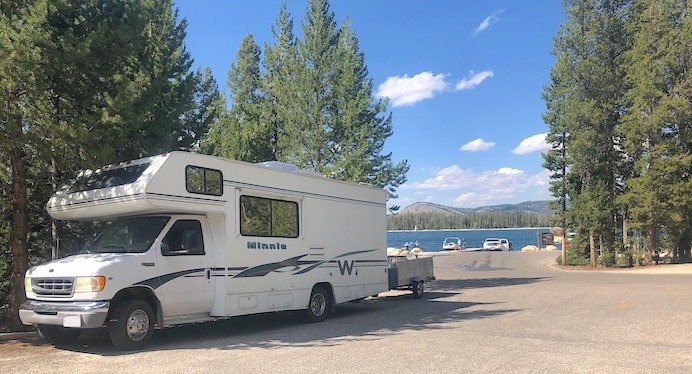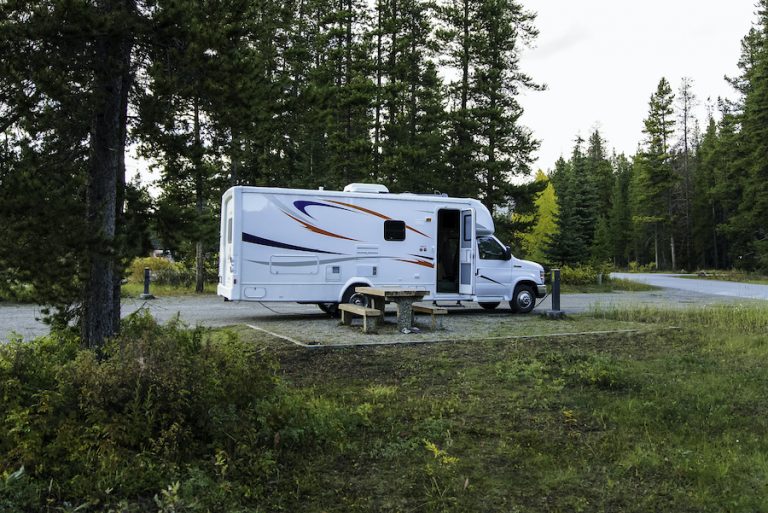15 Essential Accessories for Towing a Travel Trailer
Life with an RV will be easier with the right travel trailer towing equipment. We were so excited when we finally found a travel trailer that would fit our family! The first thing to think about was the camper towing accessories.
What equipment do you need to tow a travel trailer?
The basic equipment you need to tow a travel trailer is an adequate tow vehicle, the correct hitch, pin and clip, wiring harness, and brake controller. Accessories such as a special hitch, programmer, gauges for your engine, and after-cooler also help.
| Towing Equipment | Importance | Where to Buy |
| Hitch Receiver | Required | Amazon |
| Ball and hitch | Required | Amazon |
| Wiring harness | Required | etrailer |
| Pins and Clips | Required | Amazon |
| Weight distribution system | Indispensable | Amazon |
| Trailer brake controller | Required | Amazon |
| Hitch Lock | Essential | Amazon |
| Wheel Chocks | Required | Amazon |
| Electric Tongue Jack | Indispensable | Amazon |
| Transmission Cooler | Helpful | Amazon |
| Cold Air Intake | Helpful | Amazon |
| Transmission Temperature Gauge | Helpful | Amazon |
| Engine Programmer | Helpful | Amazon |
| Wireless Back-Up Camera | Indispensable | Amazon |
| RV GPS | Indispensable | Amazon |
List of Equipment for towing a travel trailer camper:
Note some equipment may be required by law or necessity
Yes, indeed tow vehicle equipment and accessories are necessary. There are some really important things to have for towing a travel trailer. Some things are even required by law such as a brake controller for trailer brakes. Others have major safety improvements.
Most RV accessories and tow vehicle equipment can be bought online or at the local trailer shop. This equipment can be installed by an RV shop, a mechanic or an avid DIYer.
Pro Tip: With a new truck and trailer set up, some of this may come as a package from the dealer so make sure to ask what is included in your purchase and what costs extra. Hopefully, you are reading this in the shopping stage!
Hitch Receiver
A hitch is necessary for towing a travel trailer if you plan to actually move the trailer. The hitch assembly actually has a couple of parts – the hitch receiver, the ball mount, the ball, and the wiring harness.
A travel trailer connects to the bumper hitch of the towing vehicle. The tow vehicle can be a truck, SUV or van, as long as it has the correctly matched towing capacity and has a hitch. The hitch receiver is mounted to the frame of the tow vehicle. For travel trailers, class III, IV or V hitch will be required.
Even if your truck does not have a hitch receiver, you can install one.
Ball hitch
The ball mount and the ball actually slide in and are fastened with a pin in the receiver. For a travel trailer, the correct size ball hitch will be required. The size of the ball and the weight rating must match the travel trailer. In general, travel trailers require a 2 5/16 ball. Sometimes 2-inch is required for small or light trailers. You can get an adjustable drop hitch to connect at exactly the right point or a more economical basic hitch.
The hitch installation is easy – it will slide right into the hitch receiver in the back of the vehicle. But you can always check with your local trailer shop for help.
Note: A fifth wheel is a different kind of trailer. A fifth wheel requires a fifth wheel hitch installed in the bed of the truck. Fifth wheel hitches can be a basic hitch or, if the truck bed is short, a sliding hitch may be required.
Another popular option is to change the hitch on a large heavy camper and the tuck to a gooseneck. This hitch is more versatile because many other trailers, such as flatbed and horse trailers, have a gooseneck.
Wiring Harness
The wiring harness connects the power supply from the tow vehicle to the trailer. This will power the lights, trailer brakes, and other necessary equipment.
Generally, a wiring harness will already be on the tow vehicle. If you look near or just under the back bumper you will see wires that look like an extension cord with a cap. The other side should already be on the trailer.
When you hook up the trailer to the tow vehicle you simply plug in both ends.
If you are installing a hitch on your vehicle you may need to have a mechanic install the wiring harness as well. It simply plugs into the vehicle’s wiring system is available or you may need to hardwire it.
This table is perfect for finding the correct wiring harness and purchasing one – etrailer
Weight Distribution System and Sway Bar

A weight distribution hitch or stabilizer can be used in place of the ball. This hitch is not required but will help distribute the weight evenly across the trailer and the tow vehicle.
A sway bar will add stability, helping to tow straight. When a trailer is only connected to the ball the hinge point is very small and a long trailer will have movement. The sway bar adds friction to reduce the side-to-side movement of the trailer while towing.
Generally, the weight distribution hitch and sway bar come as a set. Both are hooked up at the same time.
Pins and Clips
Pins are used to secure the ball mount in place. This keeps the hitch from slipping out of the hitch receiver on the truck.
Clips are used to secure the hitch on the trailer to the ball. Clips are also necessary for connecting a stabilizer and sway bar set up too.
These are actually easy lost when you are loading and unloading or storing. It’s best to have a couple of extra clips on hand.
Trailer brake controller
In general, separate trailer brakes are required on any trailer greater than 3,000 pounds. With separate brakes on the trailer, you are not relying on the brakes of the tow vehicle to stop the entire load.
We cover the laws for trailer breaks in each state here. Some small trailers do not need a separate braking system: read more here.
A brake controller is mounted inside the vehicle on the driver’s side, under or near the steering wheel. It is connected to the tow vehicle braking system.
The brake controller engages the trailer’s electrical braking system, either time-delayed or in proportion to the tow vehicle’s brake engagement. The trailer should come equipped with a braking system that will be activated with the controller in the vehicle.
The controller will need to be installed in the tow vehicle and connected to the trailer brake system. Trucks and SUVs with towing capabilities generally have a plug for the controller.
Note: When we changed tow vehicles an adapter was needed for a different plug, but we used the same controller. Otherwise, additional wiring may need to be installed.
Hitch Lock
Unfortunately, theft is a problem with travel trailers. A hitch lock prevents someone from connecting to your trailer and driving away. So this accessory is more for the trailer while it is parked.
Hitch locks come in different styles but are basically attached to the coupler on the trailer side and prevent someone from attaching their hitch. This is a very small investment that you should make right away.
Wheel Chocks
When the trailer is parked you need to secure the wheels so so they do not move. You will need to place chocks under the tires to prevent the trailer from rolling while it is parked.
When you park at your campsite you will first place the wheel chocks. This prevents the trailer from moving even before you unhitch the vehicle.
This is likely one of the cheapest accessories you will buy for towing. You can buy the basic plastic yellow wheel chocks or the nicer x-chock style.
Electric Tongue Jack
The tongue jack is in the front of the trailer and supports the trailer when it is not connected to the tow vehicle. It is raised and lowered wither manually by hand or on an electric motor.
After placing the wheel chocks and before unhooking the hitch you will lower the tongue jack. This supports the weight in the front of the trailer so it does not tip forward.
Many trailers come with an electric tongue jack. I did not appreciate the help from an electric one till the battery was dead. I had to hand-crank a tongue jack for a large travel trailer. It’s a lot of work and an electric one will make life so much easier.
Transmission Cooler for the Tow Vehicle
Many trucks and SUVs may have a tow package that indicates the tow capacity and rating for the vehicle. However, when towing long distances, up hills or at altitude, you will be stressing the engine.
A second cooler adds to the heat exchange for the transmission to help it run most efficiently. Just like everything else, these range in features and price. You can install it yourself, have your personal mechanic do it or check with your local trailer store. B&M makes some of the best after-market coolers. You need to make sure you choose the correct cooler to match your truck but here is an example.
Cold Air Intake
The engine is cooled by moving the fluid from the transmission through the engine and outside air being pulled in. A cold air intake increases the amount of air flowing over the engine to keep it cool.
It will also pull in cooler air since it sits a little lower and away from the engine.
The continuous work of towing increases the temperature of the engine which can lead to overheating and increased wear on the engine. The cold air intake should be about $100 – $300 and you can install it yourself or have a mechanic do it. You need to have the correct one to match your vehicle and K&N is one of the best brands out there. Check prices on amazon.
Transmission Temperature Gauge
Towing increases the load on your vehicle and makes it work harder. The transmission can become hot or easily overheat, even with the other add ons.
The temperature gauge on the dash measures the temperature of your engine in general and will only let you know once you are in danger of overheating.
When you are towing you need to keep the transmission fluid temperature in the correct range, between 175 and 225 degrees F. Keeping the temperature lower will increase your towing and engine efficiency. It will increase the life of your transmission and other engine parts.
The transmission temperature gauge is installed it will show the temperature of the transmission fluid while you are driving.
Engine Tuner or Programmer
Generally, if your vehicle is already prepared with a tow package, your engine is ready to tow. The stop options should be able to efficiently to a travel trailer.
However, many avid RVers with diesels like use an engine tuner or programmer for extra power when towing. A tuner will increase your power and torque while towing.
Some programmers even read out engine codes when the check engine light comes on. So you will have an idea of what caused the check engine light to come on before calling your mechanic.
We used a programmer when towing a long heavy travel trailer. It seemed to boost the power in the engine. Although the tuner can increase fuel efficiency, I did not see much difference.
Also, you might void your warranty if you have a new truck so be careful if your vehicle is still under warranty. You will need to match the tuner to the make and model of your vehicle. Here is one of the best gas tuners: Bully Dog 40417 GT Platinum Tuner for Gas Applications
RV Back-Up Camera
Back-up cameras are becoming very popular on trucks and campers, for good reason. You can’t see anything behind you. You can add backup cameras to the back of your tow vehicle as well as the camper itself.
We installed a camera on the truck and use it to back up exactly to the location of the hitch. You can match the ball and hitch much better with the camera than someone standing back there directing you. And that’s one less thing to stress about when we are loading up!
You can install a wireless camera to the back of the camper to see everything behind you. Between the mirrors and the campers, gone are the days of me hopping out and directing someone.
RV GPS
After being stuck on closed roads and places too tight to turn around, an RV-specific GPS is invaluable. An RV is much longer and taller than a regular vehicle so a GPS can make life so much easier. You can get an app for your smartphone and use that.
Another option is the portable GPS will plug right into the power outlet in your vehicle. Some models combine GPS and back camera in one monitor. That’s great because the dash can start to get cluttered with all the new accessories.
RV Supplies
A few additional accessories will make your RV camping experience more enjoyable.
Generator to Supply Power to the Camper
Your RV will come equipped with two power systems. One that runs off 110V alternating current (AC), just like everything in the house. Anytime the camper is plugged you have a constant supply of electricity for the air conditioner, appliances and 110 outlets.
The other is the system that runs off the battery or direct current (DC) system. This system operated when you are not plugged in.
The problem is the battery has a limited amount of power – you can’t run an air conditioner or other large appliances- and limited life. If you want to power your appliances, like the hairdryer and air conditioner, when a power outlet is not available, you need a generator.
Generators can be loud and that mechanical noise drives me crazy in the peaceful outdoors.
So we opted for this quiet generator with enough Watts to run everything we wanted. This site has a good tutorial to help you figure out how large a generator to buy.
Extra Batteries the other Power Supply
When not connected to the power outlet the camper will run on the 12V DC system from the batteries.
New campers should come with one 12 Volt deep cycle battery. An older camper will likely have an older battery as well. You may want a new battery or more power requiring more batteries.
You can choose a new 12-volt battery or two or more 6-volt batteries for a little more power. This is a good discussion of batteries and care.
Surge Protectors
Another RV power accessory that is a must-have is a surge protector for plugging your RV into shore power. That’s RV speak for the power outlet at the campground. Just like protecting sensitive equipment in your home, you should protect your RV from voltage spikes with a surge protector. If you do not have protection built in you should get 15, 30 or 50 Amp surge depending on the power requirements for the RV.
Traveling in an RV is so much fun and great for the family. I hope some of these suggestions for RV supplies and towing vehicle accessories make your RV camping experience a little easier and safer!
RV Destinations You Will Love
- Places to Camp in Fall
- RV Destinations in October
- Incredible RV Destinations in November
- Places to Camp for Thanksgiving
- Places to Ring in the New Year
- Magical Places to Camp this Christmas
- RV Destinations for December
- Places to Camp in February
- Places to Camp this Spring
- RV Destinations for Spring Break
RV Rental Information
What do you plan to buy for your RV? What are your favorite accessories?
Aside from the accessories that I get for my RV, another thing that I make sure I am always prepared for is the travel plans for our destination.
It’ll be a good measure to have planners for your campground arrival set-up. This planner will surely help you keep track of the most important bits and pieces of the campgrounds. You’ll never forget important details again because it’s all in one handy place! How cool is that?
Be sure to check our Etsy store, in there I have many other planners and journals that you might find helpful for your camping needs.


















